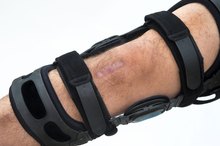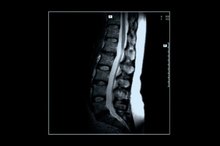What does fact checked mean?
At Healthfully, we strive to deliver objective content that is accurate and up-to-date. Our team periodically reviews articles in order to ensure content quality. The sources cited below consist of evidence from peer-reviewed journals, prominent medical organizations, academic associations, and government data.
The information contained on this site is for informational purposes only, and should not be used as a substitute for the advice of a professional health care provider. Please check with the appropriate physician regarding health questions and concerns. Although we strive to deliver accurate and up-to-date information, no guarantee to that effect is made.
Knee Replacement & Sciatic Nerve Complications
Knee-replacement surgery offers the hope of returning to typical duties and physical activities without having to deal with debilitating pain 1. And while elimination of pain is part of the goal of surgery, the surgery itself presents its own pain possibilities, especially in regards to the sciatic nerve and complications that may arise.
If you are experiencing serious medical symptoms, seek emergency treatment immediately.
Knee-Replacement Surgery
According to the Mayo Clinic, total knee arthroplasty (also known as knee-replacement surgery) is performed in order to reduce pain experienced as a result of a diseased knee bone 12. The surgery not only reduces the pain; though, it also helps to restore function of the damaged knee. But knee-replacement surgery is not without potential problems, which can include normal sciatic nerve pain as well as other sciatic nerve complications 1.
Sciatic Nerve
Why Do I Still Limp After My Hip Replacement?
Learn More
The sciatic nerve is long—the longest one in the body, actually—and it runs from the spinal cord all the way down the length of both legs. A number of things can cause:
- pain to radiate along the path of this nerve
- according to the Mayo Clinic: a herniated disk
- trauma
- tumors,
- injuries— including nerve damage sustained during knee-replacement surgery 12
And although most people recover from sciatic nerve pain, some individuals suffer permanent damage of this nerve too.
Postoperative Pain Complication
Postoperative pain is substantial after knee-replacement surgery, according to the Journal of the American Academy of Orthopaedic Surgeons 1. And that pain remains fairly constant for a substantial period of time after surgery. So individuals undergoing this type of surgery must have some type of pain management after knee surgery in order to heal properly and to begin their physical therapy.
The traditional method of addressing postoperative knee surgery pain has been to administer analgesia through either an intravenous (IV) drip or an epidural. But according to the Journal of the American Academy of Orthopaedic Surgeons, peripheral nerve block is the newest means of addressing the need to reduce sciatic nerve pain after surgery.
- Postoperative pain is substantial after knee-replacement surgery, according to the Journal of the American Academy of Orthopaedic Surgeons 1.
- But according to the Journal of the American Academy of Orthopaedic Surgeons, peripheral nerve block is the newest means of addressing the need to reduce sciatic nerve pain after surgery.
Rehabilitation Complication
Complications After Cubital Tunnel Surgery
Learn More
In the past, when the patient has relied on traditional pain-management approaches to address sciatic nerve pain after knee surgery, it has sometimes led to the inability to adequately perform the needed physical therapy due to the unresolved pain. This, in turn, results in not achieving necessary rehabilitative goals and prolongs hospitalization. So addressing sciatic nerve pain effectively can aid the patient in completing rehabilitation therapy and getting to go home.
Other Possible Complications
In addition to unbearable nerve pain, the sciatic nerve can cause other complications if it is being compressed or has been injured, either as a result of knee-replacement surgery or due to some other means 1. These possible complications can include an inability to control the bowels and bladder, the inability to move or feel the leg affected by surgery.
Related Articles
References
- Mayo Clinic: Knee Replacement
- Mayo Clinic: Sciatica
- American Academy of Orthopaedic Surgeons. Sciatica. Updated December 2013.
- Caridi JM, Pumberger M, Hughes AP. Cervical radiculopathy: a review. HSS J. 2011;7(3):265-72. doi:10.1007/s11420-011-9218-z
- Marco C, Miguel-Pérez M, Pérez-Bellmunt A, et al. Anatomical causes of compression of the sciatic nerve in the pelvis. Piriform syndrome. Rev Esp Cir Ortop Traumatol. 2019;63(6):424-430. doi:10.1016/j.recot.2019.06.002
- Ajala-Agbo T, Tang PT, Bat-Ulzii Davidson T. Unilateral leg weakness and pain secondary to metastatic anal squamous cell carcinoma. BMJ Case Rep. 2019;12(7):e227563. doi:10.1136/bcr-2018-227563
- Horment-Lara G, Cruz-Montecinos C, Núñez-Cortés R, Letelier-Horta P, Henriquez-Fuentes L. Onset and maximum values of electromyographic amplitude during prone hip extension after neurodynamic technique in patients with lumbosciatic pain: A pilot study. J Bodyw Mov Ther. 2016;20(2):316-23. doi:10.1016/j.jbmt.2015.08.006
- Rhanim A, El Zanati R, Mahfoud M, Berrada MS, El Yaacoubi M. A rare cause of chronic sciatic pain: Schwannoma of the sciatic nerve. J Clin Orthop Trauma. 2013;4(2):89-92. doi:10.1016/j.jcot.2013.04.001
- Mariniello G, Malacario F, Dones F, et al. Sudden post-traumatic sciatica caused by a thoracic spinal meningioma. Neuroradiol J. 2016;29(5):390-2. doi:10.1177/1971400916655479
Writer Bio
Holly Huntington's writing has been published online by eHow.







